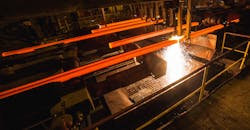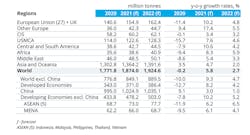Global Steel Demand Recovering in 2021
The World Steel Association forecasts that global steel demand will rise 5.8% this year to 1.87 billion metric tons, then a further 2.7% to 1.92 billion metric tons in 2022. Demand from automotive and construction sectors offer the best prospects for growth. These predictions follow a year of slightly declining (-0.2%) demand in 2020, with major consuming industries like automotive and construction beset by pandemic-related restrictions and supply-chain disruptions.
World Steel added that its new forecast assumes that second- or third-waves Covid-19 outbreaks will stabilize in Q2 2021, and that vaccinations will contribute to “a gradual return to normality in major steel-using countries.”
According to Saaed Al Remeithi, chairman of the World Steel Economics Committee, “the global steel industry was fortunate enough to end 2020 with only a minor contraction in steel demand. This was due to a surprisingly robust recovery in China, with growth of 9.1%. In the rest of the world steel demand contracted by 10.0%.”China’s recovery -- China, where the pandemic originated, initiated economic shutdowns in February 2020, as noted by World Steel, but almost economic sectors (except retail) had resumed full productivity by May 2020. Subsequent economic activity in China has not been affected by the pandemic, and that economy benefited from various government stimulus measures, including infrastructure projects and relaxing tax and regulatory measures to spur consumer spending.
After contracting by 6.8% in Q1 2020, China's economy recorded annual growth of 2.3% in 2020.
World Steel also emphasized the benefits China derived by exports “as the rest of the world was affected by the pandemic.”
China's GDP growth is forecast to increase to 7.5% or higher in 2021, and then to moderate to 5.5% in 2022.
Chinese steel demand is seen growing by 3.0% in 2021, and then slowing to 1.0% growth in 2022.
U.S. steel demand -- The U.S. economy made a strong recovery from the March 2020 pandemic wave due to substantial fiscal stimulus supporting consumption, which helped durable goods manufacturing. However, overall U.S. steel demand fell -18.0% year-over-year in 2020. A new infrastructure plan “may have upside potential for steel demand in the longer term,” according to World Steel, but short-term steel-demand recovery will be limited by weaknesses in non-residential construction and energy sectors.
On the other hand, the U.S. automotive sector is forecast to recover considerably.The developed economies -- European Union steel consumption “suffered severely from the first lockdown measures in 2020,” World Steel noted, but it staged a stronger than expected post-lockdown rebound in manufacturing activities due to government intervention and pent-up demand.
Thus, 2020 steel demand in in the EU and the U.K. contracted -11.4% year-over-year: the decreases were somewhat greater in Italy and France, due to more severe lockdown measures and a lack of tourism.
The EU’s recovery in 2021 and 2022 will be “healthy, driven by recovery in all steel-using sectors, especially the automotive sector, and public construction initiatives,” according to World Steel.
The Japanese economy suffered from the pandemic due to the interruption of broad economic activity and weak confidence, adding to the effect of an October 2019 consumption-tax increase. Falling automotive production contributed significantly to a -16.8% drop in Japanese steel demand declined by 16.8% in 2020.
Japanese steel-demand will be moderate, mainly due to recovering automotive and industrial machinery exports as capital spending rises worldwide.
Steel demand in the developing economies (excluding China) declined -7.8% in 2020. India’s steel demand fell -13.7% in 2020 but is seen growing 19.8% in 2021, topping 2019 demand.
Developing markets -- ASEAN markets saw steel demand decrease -11.9% in 2020. Malaysia and the Philippines were most severely hit; Vietnam and Indonesia saw smaller declines in steel demand. This region’s recovery will be shaped resumption of construction projects and tourism, according to World Steel.
Latin American economies were hit hard by the pandemic and 2020 steel demand saw a double-digit contraction in most of the region. Mexican steel demand was hard hit by reduced auto production and investment. A quick automotive-sector recovery and a strong U.S. economy should boost Mexican steel demand in 2021.
The Brazilian economy rebounded after Q2 2020 and so steel demand rose slightly in 2020. It should continue to recover at a healthy pace in 2021 and 2022, according to World Steel.
Steel consumption -- Addressing specific steel-consuming sectors, World Steel foresees the global demand for construction-grade steel relying on logistics-related developments as well as longer-term “green recovery” and infrastructure programs. It sees global construction activities returning to the 2019 by 2022.
In contrast, the automotive sector is marked for a solid recovery in 2021, driven by pent-up demand, increased use of personal transportation, and increased personal savings.
This automotive recovery is expected to be particularly strong in the U.S., where the production level in 2021 will exceed the 2019 level, according to World Steel. The global automotive industry is seen regaining its 2019 level in 2022.
Last, the industrial machinery sector suffered from cuts in capital investment during 2020, and supply-chain disruption was another considerable factor. Improvements to supply-chain flexibility and reliability, and an accelerating trend toward digitization and automation will drive growth in industrial machinery demand in 2021, World Steel indicated.
“In the coming years,” Al Remeithi continued, “steel demand will recover firmly, both in the developed and developing economies, supported by pent-up demand and governments’ recovery programs. However, for most developed economies a return to the pre-pandemic levels of steel demand will take a few years.”


